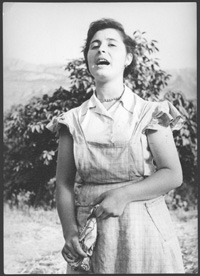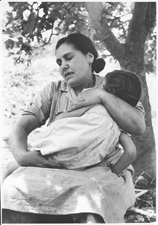Life and calendar cycle songs. There are songs for most of the events of the calendar cycle: Christmas, Carnival, Easter, major saints’ days, and the annual pig-slaughtering celebration. The life cycle is represented mostly by lullabies and courtship songs, as Mallorcan folklore does not include wedding songs. Long romanzas are not unusual, almost always sung a capella.
This is a semi-improvised set of verses, many with erotic double meanings during which the singers seemed to be self-censoring their words, probably because of the presence of a stranger. This first stanza refers to a morning service with a floral offering (oferta) to a saint, with a slow, ceremonial dance accompanied on a bagpipe. This was popularly considered to be quite boring. This explains why the opening stanza reproduced here says one cannot go to this oferta with a friction drum (whose erotic symbolism is well-known) and a good body because the erect “sparrow” (euphemism for penis) will wake up the sleepy young people. El Cant de la Sibil∙la. The Song of the Sybil is one of the most interesting aspects of Mallorcan folklore. On Christmas Eve, after matins and before the mass, a twelve-year old boy (or, in recent times, a girl) goes up to the pulpit, colorfully dressed as a woman and carrying a large shining sword in both hands. This is the representation of the Sybil, a pagan prophetess. In early Christianity, it was conceded that God gave some prophesying power to those pagan woman diviners, to predispose people to accept the gospel. The song text is apocalyptic, and relates the disasters and signs presaging the day of judgment. The stanzas are separated by musical interludes, today usually played by a pipe organ, in some parrishes as improvisations based on Christmas melodies or lullabies.
According to the musicologist Higini Anglés (p. 289) the Song of the Sybil is the oldest known Catalan theatre piece. He explains that it is documented in Ripoll, Catalunya, in the tenth century and spread throughout Catalunya, where it was performed until the sixteenth century. It is still sung in Alguer, the Sicilian town where Catalan is still spoken and with a more complete text than is found now in Mallorca (Sanchis Guarner 14). When Mallorca was conquered, plainchant and the Roman liturgy were introduced, and the Song of the Sibyl was introduced with the same Mozarabic melody which was used in Catalonia, France, and Italy (13). Anglés goes on to say that this melody went through a series of changes, often using imitations of popular Mallorcan Christmas songs, finally emerging as the melody performed today. The transcriptions made by Noguera (43) have been taken as a model for the modern singers, thus reducing the process of oral transmission. There is a certain mystique of preparation for performing the Sybil song. Judith Cohen observed, “in the late 1970s, a nun in the convent of Santa Magdalena sang the Sybil for me, and told me she always sucked a candy before singing it to lubricate her throat – exactly as a sixteenth century nun of the same convent relates in Caimari (p18)” (personal correspondence). Francesc Vicens has observed (2004) that when children are chosen to learn the song, they are given figs, raw eggs, and sweet wine to keep their voices smooth. Even nowadays, in the Convent of the Conception in Palma, it is customary for the performer of the Sybil to eat an egg yolk candy before singing. Many modern recordings of the Sybil have been published, from academic versions by Jordi Savall to traditional and folklorized versions (Coral Universitària, Capella Mallorquina, Blavets de Lluc), including more ornamentated renditions (Maria del Mar Bonet 1979) and even New Age versions (Dead Can Dance1994). |
16. Gender roles
|
Men and women alike are dance soloists, improvise gloses, and sing most types of work song, with the exception of lullabies (also known as vou-veri-vou in Mallorca) and olive picking songs, which are sung only by women. Singers of the Song of the Sibyl are always children and, on the rare occasions it is performed outside the church by adults, it is only by women, the tradition being that only “white” voices can sing the melody properly. Until recently, women rarely played any instrument except for small percussion instruments. Shepherds’ songs and the cossiers’ dance were always performed by men. Sometimes men sing love songs, including those in the voice of a woman, but women would rarely sing love songs in the voice of a man.
|

